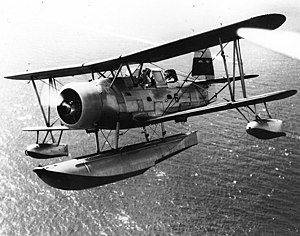Curtiss SOC-4
| SOC Seagull | |
|---|---|
 |
|
| Seagull seaplane configuration in flight | |
| Role | Scout |
| National origin | United States |
| Manufacturer | Curtiss-Wright |
| First flight | April 1934 |
| Introduction | 12 November 1935 |
| Retired | 1945 |
| Primary users |
United States Navy United States Coast Guard United States Marine Corps |
| Produced | 1935-1940 |
| Number built | 322 (258 by Curtiss, 64 by the NAF) |
The Curtiss SOC Seagull was an American single-engined scout observation biplane aircraft, designed by Alexander Solla of the Curtiss-Wright Corporation for the United States Navy. The aircraft served on battleships and cruisers in a seaplane configuration, being launched by catapult and recovered from a sea landing. The wings folded back against the fuselage for storage aboard ship. When based ashore or on carriers the single float was replaced by fixed wheeled landing gear.
Curtiss delivered 258 SOC aircraft, in versions SOC-1 through SOC-4, beginning in 1935. The SOC-3 design was the basis of the Naval Aircraft Factory SON-1 variant, of which the NAF delivered 64 aircraft from 1940.
The SOC was ordered for production by the United States Navy in 1933 and first entered service in 1935. The first order was for 135 SOC-1 models, which was followed by 40 SOC-2 models for landing operations and 83 SOC-3s. A variant of the SOC-3 was built by the Naval Aircraft Factory and was known as the SON-1.
The first ship the SOC was assigned to was the light cruiser USS Marblehead in November 1935; by the end of the decade, the SOC had replaced its predecessor throughout the fleet. Production came to an end in 1938. By 1941, most battleships had transitioned to the Vought OS2U Kingfisher and cruisers were expected to replace their aging SOCs with the third generation SO3C Seamew. The SO3C, however, suffered from a weak engine and plans to adopt it as a replacement were scrapped. The SOC, despite belonging to an earlier generation, went on to execute its missions of gunfire observation and limited range scouting missions.
...
Wikipedia
